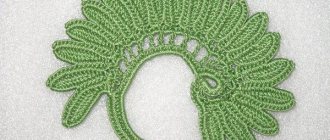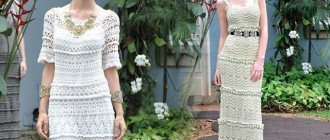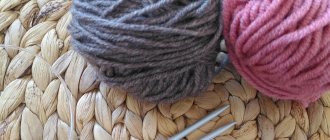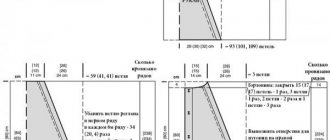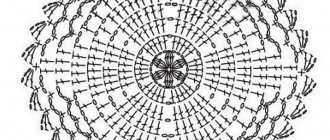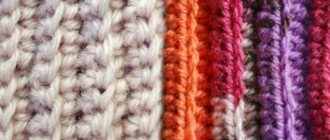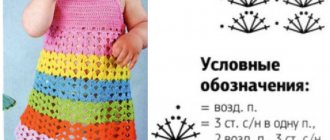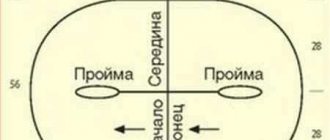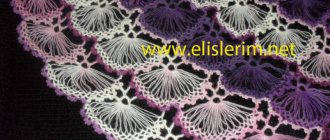The long-awaited spring time has come - the time of awakening of nature, warm sunny days and fragrant flowering of trees and herbs! However, spring time is quite changeable and capricious: now there is a breeze, now there is warm sun and complete calm, during the day it is warm, but in the evening it is already cool! What to wear in the off-season? A light coat or crocheted cardigan will help you not only complement your look, but also feel comfortable both during the day and on an evening walk. Today's lesson will be devoted to knitting such a practical and stylish part of a woman's wardrobe.
Delicate summer cardigan for women
Knitted jackets of this model will require the following materials:
- yarn (100% merino wool, 160 meters per 50 g), approx. 1050 (1150) grams pale pink;
- hook No. 4;
- silver decorative clasp.
Finished product dimensions: 34-36 (40-42).
Wave pattern: the number of loops is a multiple of 12 + 1. We knit, following the pattern. We start with the loops before rap., repeat. loops rap., finish with loops after rap.. Vol. 1 x 1-3 pp., after which repeat. 2-3 pp.
Knitting density: 19 p. x 7 p. = 10 x 10 cm.
Scheme, pattern and symbols
Important! The back and shelves are knitted crosswise in one panel. The arrow on the pattern indicates the correct direction of work.
Knitted jackets: master class for beginners
Main part
Using a hook, we collect a chain of 169 (169) chains. p. + 4 v. p.p., knit further in a wavy pattern.
After 50 (52) cm from the cast-on, we knit 55 (52) cm on the WS with a wave-like pattern, leave the next 19 cm = 36 p. (22 cm = 42 p.) for the armhole, and cast on a chain of 36 (42) sts. p. and finish the row.
We continue knitting on all loops (= back). Having knitted 18 (20) cm from the armhole, we are in the middle of the back. We make the second half of the workpiece in symmetry and finish knitting.
Sleeves
We assemble a chain of 49 (61) v. p. + 3 v. p.p. and knit another 14 cm in a wave-like pattern, and at this level we already make additions for the bevels of the sleeves on both sides in each purl row 12 x 1 p., including added loops in the pattern = 73 (85) p..
We complete the work by reaching a height of 52 cm from the set of loops.
Assembly
We make the seams of the sleeves and sew them in. It is recommended to tie jackets of this type along the top and bottom edges in one row with. without n., and then with another row of “crawfish step” (s. without n. from left to right) to maintain the shape of the product and prevent its deformation.
Black and white cardigan coat with striped sleeves
To knit a cardigan for women, we will need:
- black yarn 250 (300) grams and white yarn 150 (200) grams (75% polyacrylic, 25% wool, 162 meters per 50 grams);
- knitting needles No. 4,
- hook No. 3.5,
- 3 buttons.
Finished product dimensions: 36-38 (40-42).
Crochet pattern for 15 stitches: knit with black thread according to the diagram. Each row begins. with designation quantities in. p.p. and p. until rap., after which repeat. rap loops and end with loops after rap.. Rep. 2-3 pp..
Wave-like pattern on 13 p.: according to diagram. 1, where the persons are given. and purl. pp. Repeat rap stitches. and 1-14 pp. We knit alternating 1 rap. black and white thread.
Fantasy pattern for 4 p.: according to diagram. 2, where only individuals are indicated. pp. Purl pp. We knit all the loops according to the pattern, remove the removed loops (thread before knitting), throw the yarn overs off the knitting needle. We start with a loop before the rapport, then repeat the repeat loops and end with a loop after the rapport. We repeat 1-12 pp., at this time 1-2 and 7-8 pp. we knit it with black thread, and all the rest with white thread.
Arches (black yarn):
1 p.: p. without n.;
2 p.: *1 ss., skip 2 p., 5 s. s n. in the next p., skip 2 p.*, from * to *.
The density of knitting with a wavy and fancy pattern is 20 p. x 31 r. = 10 x 10 cm; pattern for the hook: 23 p. x 10 r. = 10 x 10 cm.
Schemes, patterns and symbols
Description for beginners
Back
We cast on 106 (109) sts and knit between the edges. wavy pattern.
For side bevels, reduce on both sides to each. 17 (12) rub. 7 (10) x 1 p..
At a height of 40 cm from the set, close the loops. We tie the closed edge with 105 (117) s. without n. and knit with a crochet pattern, starting from arrow C (B). After 30 cm from the beginning, we finish knitting the part.
Important: for the top we make a paper pattern in full size. We make decreases for the neckline by applying the blank to the pattern.
Right shelf
We cast on 53 (58) sts with knitting needles and knit between the edge loops in a wave-like pattern. We perform the left side bevel as for the back. Having knitted 40 cm, close the loops. We crochet this closed edge with 53 (58) p. without n. and continue with the pattern for the hook, starting from arrow A.
After 20 cm, we close 12 cm along the pattern on the right. After knitting another 30 cm, we finish knitting the part.
Left shelf
Symmetrically to the right.
Sleeves
We cast on 66 (74) sts with knitting needles and knit between the edge loops in a fancy pattern. After 46 cm, close the loops straight.
Assembly
We sew the shoulders, sew in the sleeves and so on. side seams of the product, after which – the sleeve seams. All edges are tied with arches, and you need to make three buttonholes, as shown in the photo: in the first arch instead of c. without n. knit 2-3 in. p.. Sew on the buttons and the crocheted cardigan for women is ready.
Option of openwork motifs
Knitting from motifs is enjoying unprecedented popularity. The Irish lace technique is very interesting, when a canvas is created from small openwork details. Painstaking work allows you to get incredible results.
Experienced craftswomen spend a lot of time doing this kind of work, so it is not entirely correct to recommend it to beginners. If you have some knitting skills and want to try your hand at another technique, try mastering Irish lace. The work consists of the following stages:
- selection of a product pattern, making adjustments to your own dimensions;
- sketch design;
- selection of patterns for knitting individual elements;
- knitting and processing (steaming) of parts;
- collecting the fabric in accordance with the pattern;
- connection of clothing parts;
- finishing the edge of the product.
You will see several diagrams of various elements below.
This video tutorial will tell you in detail how to connect related parts into a single fabric.
For novice users, we recommend knitting a cardigan for the summer from large openwork motifs.
Two types of parts are knitted - round and semicircular. You can see their diagrams below.
To work, you will need 50 grams of yarn in four different shades - green, cream, light brown and blue. When knitting a cardigan, hook number 3 is used.
To form the shelf and back, you will need 22 mugs. Of these, 7 are cream, and the remaining shades are 5 each. Also knit two blue semicircles. For two sleeves you need to knit 4 brown and green circles and 2 cream and blue circles. Connect the parts as shown in the diagram, make seams and connect the fabric to the sleeves. Add 25 cm long decorative ties in the chest area.
Article on the topic: Crochet sneakers: video tutorials with descriptions of patterns and photos
We offer you a few more descriptions of summer cardigans with patterns that can be crocheted. Follow the knitting instructions and you will have a unique piece of clothing.
Spring openwork jacket-coat with a fan pattern
To knit an openwork jacket, we will need:
- yarn (100% silk, 150 meters per 50 grams), about 12 skeins;
- hook No. 3.5;
- decorative buttons.
Finished product size: 40-42.
Openwork fan pattern: number of loops cr. 20 + 3 + 1 c. p.p.. We knit according to cx. 1. We start each new row with 1 or 3 stitches. p.p. instead of 1 s. without n. or 1 s. from n.. Beg. from loops before rap., rep. rap., complete with loops after rap.. Rep. 1 x 1-10 pp., after which repeat. 7-10 pp. In the fifth row issue. fans and arrows in the diagram indicate the direction of work. In the 9th row we knit accordingly.
Relief pattern: the number of loops is a multiple of 6 + 2 + 1 in. p.p.. We knit according to cx. 2. Each row begins. from 1st or 3rd century. p.p. instead of the first s. without n. or first s. s n. and flowed before rap., repeat rap., ending with loops after rap.. Repeat. 1 x 1-5 pp., after which we alternate 2-5 pp..
Hem: number of loops cr. 6 + 2 + 1. Knit in the round according to cx. 3. We start each new circle from 1st century. p. instead of the first s. without n. and end with 1 ss. in replacing c. p.. Rep. 1 x 1-2 row.
Knitting density: fans 19 p. x 7 p. = 10 x 10 cm; relief pattern: 19 p. x 13.5 r. = 10 x 10 cm.
Important! We recommend preparing a pattern for the product in advance and making increases/decreases by applying the piece to it.
Patterns, diagrams and symbols for them
Description for beginners
Back
We crochet a chain of 123 v. p. + 1 v. p.p. and knit with fans. For bevels on the sides, evenly decrease 1 rap in the 30th row. on each side, controlling the process by applying work to the pattern.
After 43 cm (about 30 rubles from the set), we tie the edge 86 s. without n. (= 21 s. without n. in rap. + on both sides 1 s. without n.), after which we continue knitting with a relief pattern.
At the same time, for bevels on the sides, we add on both sides in every 2 r. 8 x 1 p. = 102 p., including added p. to the pattern. Having knitted 14 cm in relief, leave 3 stitches for the armholes on each side and in each subsequent row 3 x 2 and 4 x 1 stitches = 76 stitches.
At a height of 35 cm, we leave 6 stitches for the shoulder bevels and in each subsequent one. row 2 x 6 p..
When performing the first shoulder decrease, we leave the central 34 stitches for the neckline, and finish the sides separately. For rounding, leave 1 x 3 sts from the inner edge in the new row.
We finish knitting at a height of relief knitting of 36.5 cm.
Left shelf
We dial a chain of 63 v. p. + 1 v. p.p. and knit with fans. We make decreases on the right for the side bevel, as we did earlier on the back. Having knitted 43 cm (about 30 r.) from the set, we tie the last row of fans with the 44th p. without n. (= 21 s. without n. in rap. + on both sides 1 s. without n.), after which we continue with a relief pattern.
We make increases on the right for the side bevel and decreases for the armhole and shoulder bevel, as we did on the back. Having reached the height of the relief knitting of 23 cm, we leave 3 sts for the neckline on the left and subtract 2 sts for rounding in each. (= rows with s. s.) 3 x 2, 2 x 3 and 3 x 2 p., that is, we knit 3 or 4 s. s n. vm., we finish knitting at the height of the back.
Right shelf
Symmetrical to the left.
Sleeves
We assemble a chain of 69 v. p. + 1 v. p.p., then fans, while in the first row we perform an additional 2 arches and from the 2nd row. start and end 1 s. s n. and one full group from the village. s n. (mid rap.). Having knitted 48.5 cm (34 p.) from the set, we tie the outer row of fans with the 68th p. without n. and then with a relief pattern 3 p. (about 6 cm), after which we leave 3 p. on both sides for the sleeve roll and 2 p. in each. 4 x 2, 3 x 1, 1 x 2 and 2 x 3 p.. Having knitted 21 cm (28 r.) in relief, we finish knitting on the remaining 24 p..
Assembly
We sew the details and sew in the sleeves. We tie all the edges with a border, in the first circle we make 4 holes for buttons from the edge of the shelf (= replace 2 s. without n. with 2 v. p.). We make the first and fourth holes 3 cm from the beginning of the relief pattern, and place the remaining holes evenly between them. Sew on the buttons and the openwork cardigan for women is ready.
White jacket for women
We will need:
- yarn (50% wool, 50% polyacrylic, 55 meters per 50 grams) white, 15 (16) 17 (18) skeins;
- hook No. 7 and No. 10;
- knitting needles in the round No. 5.5, No. 6.5, No. 7, No. 7.5 and No. 8.
Finished product dimensions: 38-40 (44) 48-50.
Basic crochet pattern No. 10: odd number of stitches cast on, after cast on – even number of stitches.
We knit according to the diagram. We start with loops to rap., repeat loops rap. and end with loops after rap.. We perform 1-3 pp. x 1, after which we alternate 2-3 pp..
Elastic band: after adding stitches, start with 1 purl. r.. Edge, *1 i. p., 1 l. n.*, from * to *, 1 and. n., edge. In the front rows we knit loops according to the pattern.
Knitting density: with the main pattern 7.5 s. s n. x 4 rub. = 10 x 10 cm, average knitting density with knitting needles 15 sts x 16.5 r., knitting needles No. 7 - 17 sts x 18 r. = 10 x 10 cm.
Important! We will knit all the strips at the end of the work.
Scheme and pattern of the model
Description
Back
We crochet 39 (43) 47 sts + 3 ins. p.p., main pattern = 38 (42) 46 s. s n.. Knitting 32.5 cm = 13 r. from the bottom, close on both sides for 1 x 4 stitches. To do this, we pass these loops at the beginning of the row using ss., at the end of the row we leave them without knitting = 30 (34) 38 s. with n.. Knitting 55 cm = 22 r. (57.5 cm = 23 r.) 60 cm = 24 r., leave the central 10 s for the neckline. s n. without knitting, we finish the sides separately.
After 57.5 cm = 23 r. (60 cm = 24 r.) 62.5 cm = 25 r. from the bottom, we complete the work at 10 (12) 14 s. with n..
Left shelf
We assemble a chain of 5 (7) 9 v. p. + 3 v. p.p. and work with the main pattern = 4 (6) 8 s. s n.. To make a bevel, we make an increase on the left, starting from the casting chain, 5 x 2 s. s n. in every second row. To do this, in the front row before the last edge s. s n. we knit 2 additional s accordingly. s n. between the last s. s n. and edge s. s n. previous row = 14 (16) 18 s. with n.. We make the hole on the right as for the back. On the last 10 (12) 14 s. s n. We finish knitting the shoulder at the height of the back.
Right shelf
Symmetrical to the left.
Sleeves
We crochet a chain of 25 (29) 33 v. p. + 3 v. p.p. and continue with the main pattern = 24 (28) 32 s. with n..
To make bevels for the shoulders, add 7 x 1 s on both sides, starting from the bottom. s n. in every second row. After 42.5 cm = 17 r. from the beginning row, we end at 38 (42) 46 s. with n..
Assembly
Using hook No. 7 we tie the bottom of the back 63 (71) 79 dc..
Using knitting needles No. 5.5 for circular knitting, we cast on from each ss. 1 p. and knit for a 12 cm strip = about 20 r. with an elastic band, at this time after 4 rows we switch to circular knitting needles No. 6.5. After this, we loosely close all the loops according to the pattern and sew shoulder seams.
Using hook No. 7, we tie the edge of the shelf to the side seam 121 (125) 129 ss. and half of the back neckline to the middle - 16 dc.. On circular needles No. 5.5 we pick up from each dc. 1 p. and at 137 (141) 145 p. we knit a stripe, as we did for the back, only we start in the 1st purl row between the edges. from 1 persons. and finish with 1 knit.. We knit the left flange + 1/2 of the back neckline symmetrically.
Using a crochet hook No. 7 we tie the bottom edge of each sleeve 26 (32) 38 dc. On circular needles No. 6.5 we cast on from each dc. 1 p., then using knitting needles No. 7 we knit a strip with an elastic band, while in the first purl row we start between the edges. from 1 persons. and finish 1 purl.. After 14.5 cm = 26 r. From the beginning of the plank, we close all the loops according to the pattern.
We sew in the sleeves, adjusting them slightly along the edges. We sew the bottom seams of the straps, the seams on the sides and the seams of the sleeves, after which we sew the seam of the strip in the middle of the cut of the back neckline.
White openwork cardigan coat for women
To knit an openwork cardigan, we will need:
- yarn (70% cotton, 17% viscose, 13% polyamide, 115 meters per 50 grams), about 15 skeins of white;
- hook No. 3.5;
- knitting needles No. 4;
- circular knitting needles No. 4.5 and 80 cm long;
- 6 white buttons with a diameter of 25 mm.
Finished product size: 36-38.
Elastic band: 2 l. p., 2 i. n. alternately.
Openwork pattern of arches: according to pattern A, B and C with straight and reverse rows. The numbers on both sides show the rows. We perform the lifting loop for the beginning of the row each time according to the height of the loop as shown.
We knit the last loop of the row each time in the last lifting loop, respectively, in the last s. without n. previous row. In the width of the row, each time we start with the loops in front of the arrow a, rap. Repeat between arrows a and b, ending with loops after arrow b. We knit 1 x 1-6 stitches in height... then repeat 3-6 stitches...
Decrements in the pattern of arches: according to pattern D according to the same principle as according to patterns A, B and C. For the width of the row, we start with the loops in front of arrow a, repeat rap. between arrows a and b, end with loops after arrow b.
We start decreasing the bevels on both sides in the 5th row and until the 48th row we decrease by 1 rapport. From the 49th row we continue to knit straight with a pattern of arches.
Reducing a larger number of loops: at the beginning of the row we pass the corresponding number of loops, ss., at the end of the row we leave the corresponding number of loops undone.
Knitting density: 2 repeats, 8 rows of crochet arch pattern No. 3.5 = 9 x 10 cm; 18 stitches of elastic on knitting needles No. 4.5, stretched = 10 cm.
Model diagrams
Description
Back
We dial 121 v. p. + 1 v. p.p.. We knit according to c. And with an arched pattern, with the 1st s. without n. we knit in the 2nd century. p. from the hook and perform rap. between arrows a and b 10 times = a total of 12 raps..
For bevels on both sides, reduce as described in cx. D 1 rap. = 10 rap..
After 60 cm = 48 r. From the cast-on edge on both sides, insert 1 marker and continue knitting straight.
After 10 cm = 8 rows from the armhole marker on both sides, we decrease 1 rapport as described in “decreasing a larger number of loops” = 8 rapports. After 20 cm = 16 rows of armhole height, we finish the part.
Left shelf
We dial 56 v. p. + 1 v. p.p.. We knit with a pattern of arches, with the 1st s. without n. carried out in the 2nd century. p. from the hook and repeat the rapport between arrows a and b 4 times = a total of 5.5 rapports. We make the bevel on the right side of the 5th row and the armhole on the right side at the same height as on the back = 3.5 repeats. Then we continue knitting straight again. After 12 cm = 10 r. The height of the armhole on the left side for the neckline is reduced by 1 rapport, then on 4 rows we decrease another 1/3 rapport in total, and we perform the decreases as for the side bevels. After 8 cm = 6 rows of neck height we finish the piece.
Right shelf
We knit symmetrically, while working according to cx. C and in the first row 1st s. from 2 n. performed in the 8th century. p. from the hook.
Sleeves
The arrows on the pattern indicate the knitting direction. First we knit the upper part of the sleeve. To do this, dial 76 v. p. + 1 v. p.p.. We knit according to c. B, while 1st s. without n. carried out in the 2nd century. p. from the hook and repeat the rapport between arrows a and b 6 times = a total of 7.5 rapports. After 47 cm = 38 rows from the cast-on edge we finish the piece.
Now we lift 58 loops from the cast-on edge, while working with a crochet hook and then transferring them to the knitting needle.
For the cuffs we knit an elastic band, while in the 1st row = purl row after the edge loop we start with 1 purl and evenly decrease 20 sts = 38 sts. After 12 cm from the width of the cuff we close the loops.
Assembly
We stretch the parts, moisten them and leave them until completely dry. We sew the seams, leaving 4.5 cm open at the top of the sleeve seam.
On circular knitting needles, cast on 152 stitches along the vertical sections of the shelves.
For the strap we knit with an elastic band, each time starting with 1 purl. row and after the edge loop with 2 purl..
In the 6th row of the plank on the right shelf we make 6 buttonholes. For each loop we close off 2 stitches and in the next row we again cast on 2 loops.
We make the first loop in the 6th purl edge from the top edge, the remaining 5 loops are located in each subsequent 4th purl edge. After 4 cm of the height of the bar, close the loops.
Now, on circular knitting needles along the neckline, including each time half of the narrow side of the placket, we cast on 103 sts, with 27 sts from the front neckline and 49 sts from the back neckline.
For the collar in the 1st row we distribute the loops as follows: edge stitch, 26 stitches knit with an elastic band as at the beginning of the row, edge loop. The edge loop in the front and back rows is knitted as a purl.
After 3 cm of collar height, separate purl. double the sts on the back of the neck = 120 sts.
Then we knit sequentially with an elastic band on all loops. After 12 cm of collar height, we loosely close the loops. We sew in the sleeves, sew on the buttons and the openwork summer cardigan is ready.
Elegant openwork cardigan
Openwork cardigans look best, because they can emphasize the elegance of the “main” outfit.
Materials required for work:
- 550 grams of microfiber yarn.
- Special hook No. 4.
Description of work and diagram:
- First row. Let's cast four chain loops and two large double crochet stitches and a double crochet stitch.
- Between each pair of volumetric columns we create two single crochets.
- Repeat the first knitting step.
- We create the required number of repeats for a certain length.
- Let's finish it all off with a border of shells; I knit a chain of six chain stitches into every second stitch
- We connect the parts and tie two chain ties for the shelves.
- This pattern is also suitable for a crocheted cardigan model for girls, only the diagrams and description need to be calculated according to the desired size, then the pattern will turn out even.
Warm cardigan-coat
For cardigan-coat models, you need to choose voluminous patterns so that the product is warm.
Materials required for work:
- 500 grams of wool yarn.
- Special hook No. 3.
- Five buttons.
Description and diagram:
- We create a chain of air loops from a number of 28.
- We knit a double crochet, a single crochet in the 2nd chain from the hook.
- Repeat the previous step until the end of the row.
- Let's create the second row. First chain stitch, turn the product, double crochet and single crochet in the first loop, skip the next particle.
- Repeat the fourth knitting step until the end of the row.
- We knit the entire product and repeat steps 2-5.
- Let's connect all the parts, steam our product and sew on the buttons.
- Such patterns also look great on crocheted cardigans with a hood . The diagrams and description do not change at all, only two elements of the hood are added, which we then sew and stitch to the neck of the base.
Regular Crochet Patterns for Cardigans
Cardigans knitted with the “Shell” pattern look very cute, especially if the threads are quite dense. Materials required for work:
- 600 grams of acrylic yarn.
- Special hook No. 4.
- Six buttons.
Description and diagram:
- We create the first row with double crochets.
- Three double stitches, eight double stitches, separated by one auxiliary chain stitch, knitted into one warp.
- We repeat the previous step.
- Three double stitches, four auxiliary loops, a single double stitch , four chain stitches. Repeat until the end of the row.
- We repeat steps 2 - 4 until a certain length of the item.
- Let's connect the parts of the back and the front, steam them and sew on the buttons.
Bright coat made of square motifs
For a coat of square motifs we will need:
- yarn (100% wool; 68 meters per 50 grams) – 100 grams each of brown, yellow, orange, red, red-brown, purple, deep pink, burgundy, light green, blue- black, blue, powder color, olive. colors and 50 grams each of lilac, blue and mint colors;
- hook No. 6;
- 5 orange buttons with a diameter of 24 mm.
Finished product size: 38-40.
Basic pattern: the number of loops is a multiple of 3 + 2. We knit according to cx. 1, starting from the loops in front of the rap., We constantly repeat the rap. and finish with loops after rap..
We perform 1 x 1-4 pp., after which we constantly repeat 3-4 pp., observing the correct alternation of yarn colors.
How to alternate colors in the main pattern
2 rows each *olive, light green, yellow, orange, red, red-brown, brown, ** burgundy, deep pink, powder color, lilac, violet, light blue, dark blue , blue-green, mint color, repeat from *.
Knitting square motifs
We perform a chain of 6 v. p. and close it into a ring using ss..
We knit according to pattern 2 in the round. We start each new row with the 3rd century. p.p. instead of 1st s. with n., and end with ss. in the 3rd century. n. replacements.
We perform these rows x 1, observing the alternation of colors.
Sequence 1: 1 p. mint, red, orange, purple. and brown colors.
Sequence 2: 1 p. blue, orange, deep pink, light green. and blue.
Sequence 3: 1 p. light green, deep pink, purple, mint and burgundy colors.
Sequence 4: 1 p. olive, yellow, red, violet. and blue-green. colors.
Sequence 5: 1 row each: light green, orange, deep pink, powder-colored thread and brown. colors.
Sequence 6: 1 p. blue, orange, red, light green. and blue.
Sequence 7: 1 p. light green, red, deep pink, powder-colored thread and burgundy color.
Alternate 8: 1 p. lilac, violet, light green, orange. and brown colors.
Alternate 9: 1 p. yellow, deep pink, purple, mint and burgundy colors.
Alternate 10: 1 p. olive, yellow, red, violet. and blue.
Alternate 11: 1 p. violet, powder-colored thread, deep pink, blue and blue-green. colors.
Alternate 12: 1 p. yellow, olive, orange, blue and burgundy colors.
Alternate 13: 1 p. mint, deep pink, light green, olive. and blue.
Alternate 14: 1 p. light green, violet, blue-green, orange. and red-brown. colors.
Alternate 15: 1 rub. a series of rich pinks, lilacs, blues, blue-greens. and burgundy colors.
Alternate 16: 1 p. mint, deep pink, light green, olive, blue-green. colors.
Plank pattern
Rapport = 4 loops. We knit the pattern according to cx. for crochet 2 (green color) along the edge of square motifs. We perform 1 x 1-3 pp..
Knitting density: 13 p. x 7 p. = 10 x 10 cm base. knot;
The size of the square motifs is 16 x 16 cm.
Schemes and pattern of the model
Description
Back
Using olive color we make a chain of 83 c. p. + 3 v. p.p., main pattern, adhering to the alternation of threads.
After 64 cm from the beginning, we pass 10 cm for the holes on both sides.
On the remaining loops we finish knitting 80 cm from the beginning.
Left shelf
We make 1 square at a time according to the alternation of colors 1–5 and in this sequence we sew it into a strip, while inserting the hook only behind the back segment of the loops.
Right shelf
We knit like the left shelf, but we knit 1 square at a time according to the alternation of colors 6–10.
Left sleeve
We make a chain of 29 V. p. + 3 v. pp and from ** we knit with the main pattern according to the alternation of colors.
To bevel the sleeves, add on both sides in every 5th row from the initial row 7 x 1 p. according to the pattern = 43 p..
At the same time, after 13 cm from the beginning, we skip the middle 21 stitches = 16 cm and then knit the two sides separately.
After 61 cm from the beginning we finish knitting.
We make 1 square at a time according to alternating colors 11–13 and sew them into stripes as described above.
We sew the strip into the sleeve.
Right sleeve
Like the left one, in the squares we alternate colors 14–16.
Assembly
We sew the shoulders on both sides with a length of 12 cm. We sew the side edges of the back to the lower 64 cm of the shelves (the outer 5 cm of the back armholes are now considered to be the shelves). We sew in the sleeves. We make the seams of the sleeves.
For the fastener strips, we tie the sides of the shelves with a strip pattern, while doing 1 row each with bright pink, powder-colored and purple thread. Then we make 1 more row of burgundy color on the sides of the shelves and the edges of the neckline.
We sew the buttons to the left shelf, while sewing the top one at a distance of about 6 cm from the top, the rest at intervals of about 11 cm. We fasten the buttons through the holes in the pattern. The original bright coat from “grandmother’s” motifs is ready!
Made from thick wool
Handmade cardigans made from the thickest yarn are in great demand , the cost of which, unfortunately, is high, considering that such a product can be knitted in just one day. Meanwhile, such things turn out to be very stylish and unusual, although the simplest patterns and models of crocheted cardigans (single crochet or single crochet) are used to make them.
Do not assume that such threads can make an exceptionally warm cardigan: now it is very fashionable to wear crochet items from the thickest yarn with short sleeves, which are ideal for sunny spring weather and even for cool summer evenings. It is noteworthy that such things are best combined with light, flowing floor-length sundresses and summer ripped jeans, although any other combinations are widely welcomed, since modern fashion is very democratic.
As an option, you can take thinner yarn, the consumption of which is more economical , and the cost is not so high. In order to make a cardigan out of it more voluminous, you can choose some interesting motif for the sleeves, which will help make the item even more stylish and original.
Children's jacket-coat for warm spring
To work on a girl's coat we will need:
- yarn (100% wool, 50 grams per 100 meters) 300 (350) 350 (400) 450 grams;
- hook No. 4;
- buttons - 5, 5, 6, 6, 6 pieces.
The size of the finished product is suitable for girls 3-4, 5-6, 7-8, 9-10, 11-12 years old.
Knitting density: 17 p. x 15 p. according to scheme A1 = 10 x 10 cm.
1 repeat according to pattern A2 = 6 cm in height.
Increases: knit 2 stitches in a row in all rows marked with markers, add before and after the marker.
Decrements: knit 2 stitches together.
Scheme and pattern of the model
Description
Main part
Knitting is done from top to bottom.
We start by dialing 77 (85) 85 (92) 100 v. p. (+ v. p. p.) and knit: 1 s. without n. in the 2nd century. p., 1 p. without n. in each of the next 5 (3) 3 (5) 3 centuries. n., *skip 1 st. p., 1 p. without n. in each of the next 4 centuries. p.*, from * to *.
We install 14 (15) 16 (17) 18 markers: 1 – after the first 5 (6) 4 (5) 6 p., the next every 4 p., the last marker before the last 6 (7) 5 (6) 7 p. .
We follow further according to scheme A.1, at the same time we make increases (see above) in every 2nd r. x 6 (6) 4 (4) 3 and then in every 4th r. x 0 (0) 2 (2) 3 = 147 (159) 165 (177) 189 p..
We continue according to scheme A.2, while in the same 7th r. schemes increase 16 (13) 16 (15) 12 p. = 177 (187) 197 (209) 219 p..
We knit the last row according to the pattern: 28 (30) 31 (33) 34 s. without n. (shelf), 6th century. p. (under the sleeve) leave the next 36 (38) 40 (43) 45 s. without n. for the sleeve, knit 49 (51) 55 (57) 61 s. without n. (back), 6 in. p., leave the next 36-38-40-43-45 s. without n. for the sleeve and knit 28 (30) 31 (33) 34 s. without n. (shelf) = 117 (123) 129 (135) 141 p..
We remove all previously installed markers and place new ones in the center of the 6th century. n. under the sleeves. We continue from the 1st row of pattern A.2, until reaching 24 (24) 24 (30) 30 cm from the beginning of knitting the armholes.
Important! For a girl 3-4 years old (smallest size), knitting is completed.
We continue to work according to scheme A.1 until we reach 28 (30) 34 (36) cm and finish knitting.
Cardigan for girls: knitting the sleeves
We start with the 3rd st under the sleeves, knit the 1st p. r.: s. without n. in each st., at the same time, evenly decrease 6 sts.
Next persons. r.: 1 s. s n. in each of the first 3 (1) 2 (0) 1 s. without n., and then we knit according to pattern A.2: section a (7 p.), after section b to the last. 8 (6) 7 (6) 7 sts and section with (6 sts), finish row 1 s. s n. in each of 2 (0) 1 (0) 1 p..
In the 4th row, decrease 5 (1) 3 (0) 2 p.. We continue according to pattern A.2, knitting the pattern repeat 3 (4) 4 (5) 5 times, at the same moment, when knitting the 3rd repeat decrease 0 (6) 6 (6) 6 p. evenly. And when pattern A.2 is knitted 4 (5) 5 (6) 6 times, continue according to pattern A.1 until the sleeve reaches 26 (30) 32 (38) 40 cm.
Assembling a coat for a girl
Cut the thread, leaving a long tip, and sew the seam of the sleeve.
Sew buttons along the edge of the left front, place the first button 1 cm from the neckline, and distribute the rest evenly. Children's demi-season crochet cardigan is ready!
Summer women's blouses and cardigans: crochet patterns
Today, long models of coarse knit cardigans are in trend. They are worn with knitted dresses and skirts. Wear with shirts and blouses tucked into wide palazzo pants.
See also...
✅ How to knit a sweater with knitting needles: diagram and description
✅ Knitting cardigans: models and patterns
✅ Three unusual hat models: knitting patterns
✅ How to knit a sweater for a woman with knitting needles: step-by-step description
A cardigan is a traditionally English item that performs a warming function. A cardigan, as a rule, is worn over a top, blouse, T-shirt, dress, trusting it to act as a second or third layer. Every woman needs it in her wardrobe, as it allows you to make your look feminine and interesting.
Cardigans made of thin knitwear have somewhat lost their relevance. But if a loose bottom is chosen, it is recommended to complement it with just such a model.
Long crochet cardigan: diagram and description of work with photos
So, we'll start with the simplest thing - a summer cardigan. The pattern is classic, openwork.
It can be made with buttons, if desired. To knit it, take 750 grams of yarn (black, definitely cotton), hook No. 2. Such a master class, patterns and descriptions are very easy even for a beginner, because the knitting process is very simple.
- The main pattern should require a number of loops that is a multiple of 9 + 2 + 4 VP. rise.
- It should be tied based on diagram below to make sure everything works out perfectly.
- Knitting begins with P. before the rapport, which should be repeated, and closed with R. Using P. after the rapport. 6 heights should be knitted 1 time (1, 2, 3, 4 R.), after which repeat knitting 2, 3, 4 R.
- So, this summer blouse is knitted from the back . Dial V.P. the required quantity. To the armhole - with the main pattern. To create armholes , stop at a length of 106 centimeters and carefully continue, following the pattern that you made earlier. Knit like this for another 19 cm. At this point we are done with the back, and you can cut the thread.
- The right and left fronts are knitted symmetrically . A more detailed description of the right shelf: again, type V.P. the length you want. Knit about 6 repeats (diagram below) to the neckline. When the canvas reaches 103 centimeters, you need to form the cutout very carefully according to the pattern. Armhole - like on the back.
- Next come the sleeves . Again a chain of V.P., then 11 rapports. Decrease P. every 1 rapport approximately 15 centimeters. Knit the sleeve cap according to the pattern.
- The most interesting thing is to assemble the cardigan: sew on the sleeves with side and shoulder seams. Tie half double crochets around the perimeter of the product. What kind of blouse without a zipper? Make it on the right shelf in the penultimate R.
For such an elongated model, you can use any color: white, green, blue, beige blue or gray. Can be worn with jeans and a knitted pullover, with a classic skirt, shorts, or combined with an openwork top.
Summer cardigan with pineapple pattern
To knit a beautiful cardigan for the summer, choose the pineapple . You will need cotton yarn in beige and cream colors . If you are not satisfied with these colors, take a brighter one. There is an alternation of knitting and crocheting here - real handicrafts. Fold the thread in half before starting work. (Below is a photo of the finished jacket).
There are two simple patterns in the work : garter stitch and “pineapple” . The first one is knitted according to the following principle: L.R. and I.R. knit with knit stitches. Purl stitch: L.R. make I.P., and I.R. – facial. “Pineapple” is the number of V.P. multiple of 14 + 1 + 1 V.P. for lifting. Then just stick to the scheme.
- 1 S.B.N. in 2 V.P. from the hook.
- Knitting should start with V.P. lifting , which is in front of the arrow, repeat the rapport with the arrows, finish the work after the second arrow.
- Starting from 5 R.S.S.N., S.B.N. in V.P. or in the loops of the previous R.
- From 1 to 13 R. – knit once .
- 6 – 13 R. Repeat 4 times to get 45 rows .
- 46 -70 R. Knit once.
- To make a beautiful, even armhole , follow the diagram. So, we begin the knitting process from the back. By the way, this cardigan is perfect for young mothers for evening walks: it is very convenient to use.
We begin to knit the back with knitting needles from 99 P. The placket is knitted 1 centimeter = 1 I.R., then purl. When you knit 47 centimeters = 136 R. from the beginning of the bar, finish the armholes on both sides with 3 P., in every second R. 1*2 P., 1*1 P. = 87 P.
After 17 cm (this is already fifty rows) from the armholes, close 29 loops in the center . This must be done in order to form a neck. it's being done. Closing 1 * 3 P. + 1 * 2 P. along the edges every 1 R. Later, two centimeters from the neck, you can close from both edges.
The left and right fronts are knitted symmetrically . Chain of 57 V.P., 1 V.P. for lifting. Perform the pineapple pattern 3 times. After 49 rows, make an armhole on the right, as shown in the knitting pattern. If you have a small clothing size, the work should be completed by knitting 70 R. for a larger size, knit another 12 cm and 2 R. S.B.N.
Sleeves 46 P. , where 1 centimeter is three R. in garter stitch, so that the first R. is purl, do it in purl stitch. To make bevels for the sleeves: 9 R. from the bar + 1 P., in every tenth R. 10 * 1 P. Close them after 43 cm. Assemble a summer women's cardigan after finishing crocheting - make all the seams, tie the neck with 1 R. S.B.N., the shelves have only vertical edges using 3 R. S.B.N. Sew in the sleeves.
Openwork crochet cardigan
A gentle knitted summer cardigan can be knitted in both small and large sizes. This knitted plot consists of openwork elements measuring 9 by 9 centimeters. It, like all the products above, consists of a back, shelves and sleeves. It can be worn as a cape, worn over a tunic, for example. Connect the finished parts of the item from the wrong side . Tie 1 S.B.N. and border (represented in the diagram).
Motif cardigan
We have only 4 colors of yarn (cream, green, blue, gray) and crochet number 3 . We recommend taking 50 grams of yarn of each color. The pictures below show diagrams with numbering. According to pattern 1, the motif is knitted . Half-motif - according to the second, finishing of the product according to the third.
Front and back: make 22 motifs (knit 5 motifs in all colors except cream. Knit seven of them. And two half-motifs in a blue tint). Connect according to the diagram. To make openwork sleeves: 12 motifs for both. 4 pieces in gray and green, 2 pieces in cream and blue. Assemble the product and sew in the sleeves. To make ties - 25 cm V.P. any color.
Blouse with round collar
If you are a fragile little girl , then this blouse with a round armhole will definitely suit you. It will highlight your figure and add grace.
Cardigan for girls
Rainbow colors of thread - 300 grams, hook No. 2.5, 3. and buttons. Make life-size pattern . We start crocheting from top to bottom: 80 V.P., three R. - S.S.N. According to the scheme, 16 “wedges” will be 18 centimeters in length.
- 3 V.P., (1 S.S.N., (this is knit in 1 loop: 1 S.S.N., 3 V.P., 1 S.S.N.), 1 S.S. N., 2 V.P. skip). We repeat the brackets again until the end of R.
- 3 V.P., 1 P. skip, (1S.S.N., into an arch of 3 V.P. - 1 S.S.N., 2 S.S.N. with 1 base + 3 V. P., 1 S.S.N.), 1 S.S.N., 2 V.P. we skip. We repeat all the steps. We close the row with 1 S.S.N., through the loop 1 S.S.N.
- 3 V.P., through one P.: (2 S.S.N., in the arch - 2 S.S.N. in 1 P. and 3 V.P.), 2 S.S.N., We skip 2 loops. Repeat everything, close as in row 1.
- 3 V.P., through a loop: (2 S.S.N., in an arch of 3 V.P. we knit – 1 S.S.N., 2 S.S.N. with one base + 3 V. P., 1 S.S.N.), 2 S.S.N., skip 2 P. Repeat everything.
- Next we knit in the same way, in each arch + 2 S.S.N. in every even R. At 18 centimeters – mark the location of the armholes. Next we knit in three parts of approximately 30 cm. We make sleeves without increases, tying them with a “crawfish step”.
We make 2 planks. According to 4 R.S.B.N. (leave space for eyelets). Here: 2 R.S.B.N., in the place for loops 5 V.P., then again S.B.N. Last R. – S.B.N.
Volumetric model
Now we will knit a short cardigan that resembles a jacket. We will need nineteen skeins of blue yarn, 75 m each (50 grams each).
- First part : width 35 centimeters, length 138 centimeters. We cast on 63 stitches and knit the length of the product with a ribbed pattern. This pattern is performed like this: 1 K.P., (2 L.P., 1 I.P.) - repeat the action in brackets until the end of R., close 1 K.P., 1 K.P. Second row: 1 K.P., 1 I.P., (2 L.P., 1 I.P.) – to the end of R., close R. 1 K.P. Repeat 1 – 2 R.
- Second part: W. – 43 centimeters, D. – 184 centimeters. We cast on 63 p., knit with a rib and close after knitting the length.
- Assembling the first part in half (product height 17 and a half cm). Make a seam from C to D of 37 centimeters. Sew what remains 64 cm at the bottom center of the first part to the top of the second. AB of the first part - opposite AB of the second part - sew up.
Knitted jacket
If you add shoulder pads to the cardigan and adhere to a certain pattern when knitting, you will get a dense product that resembles a jacket. Such things are popular among Eastern women.
Simple jackets for girls
To knit bright and warm jackets we will need:
- yarn (35% cotton, 35% polyacrylic, 30% viscose, 135 meters per 50 grams), 4 skeins of blue, 3 skeins of red, 2 skeins of light green and 0.5 skeins of blue;
- 6 buttons on the leg;
- hook No. 4.5.
Size of the finished product for girls: 110 – 116.
Scheme and pattern of the model
Jackets: description
Before you start working, you need to draw a life-size pattern according to the child’s measurements.
Based on the sample made according to diagram 1 and the patterns, we make calculations for knitting. We knit the components of the shelves, back and sleeves. Don't forget to make holes for fastening buttons on the right shelf.
Alternate colors as shown in the photo. We connect the blanks along the seams of the shoulder and sew them on the sides, leaving small holes for the pockets.
From the side slits we knit with. s n. burlap pockets and sew them together. We sew the sleeves into the armholes.
From the neckline we knit a collar to a height of 6 cm.
We finish the knitting by tying the collar, neckline and straps in 3 rows with. without n. blue thread. To form the corners we knit from 1 s. without n., located in the center of the corner 3 s. without n..
Sew on the buttons and the simplest crocheted cardigan is ready!
We hope you enjoyed our master class today. We wish you even stitches and pleasant knitting!
Advantages of handmade
Today, beginning needlewomen are offered a huge number of patterns and models of crocheted cardigans, however, among all this abundance it is not so easy to choose a truly original style. The same can be said about the store assortment: who would be surprised by a factory item these days, especially considering that manufacturers are not trying to come up with something interesting for consumers.
An ideal option would be a crocheted cardigan, which a fashionista will knit herself. Only in this case will she be able to use the model of her dreams, the desired color of yarn and its high quality, knowing for sure that the result will exceed all expectations. Not the least role in this matter is played not only by the shade, but also by the type of thread, on the composition of which a lot depends. There are popular patterns and descriptions of crocheted cardigans.
